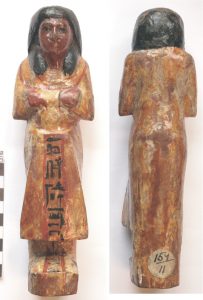W379
W379
Wooden shabti of Ptahhotep

The figure can be identified as an overseer by his kilt. Worker shabtis were usually mummiform. This item dates to the New Kingdom. Note the yellow glaze which added to the divine-like status of the shabti. The piece is 205mm high.
The text on these particular shabti’s reads: ‘The Osiris, scribe for the divine offerings of the House of Amun, Ptahhotep the Justified.’ The hieroglyphs go under the kilt of the shabti.
Shabtis were often made in groups of ten workers with one overseer. They were often placed in boxes. The shabti box belonging to these is in the Birmingham Museum.
The shabti acted as a substitute for the deceased in the afterlife and would do the work demanded from their owner. (But see Poole, F. ‘Slave or Double? A reconsideration of the conception of the shabti in the New Kingdom and the Third Intermediate Period’ in C.J. Eyre (ed.) 1998. ‘Proceedings of the Seventh International Congress of Egyptologists. Cambridge 3-9th September 1995’. Leuven : Peeters, 893-901). Purchased by Wellcome from the Frankland Hood Collection in 1924, lot 157/11. Most of the Hood items were, according to the Sale catalogue, from the Theban area.
Other shabtis in the Egypt Centre